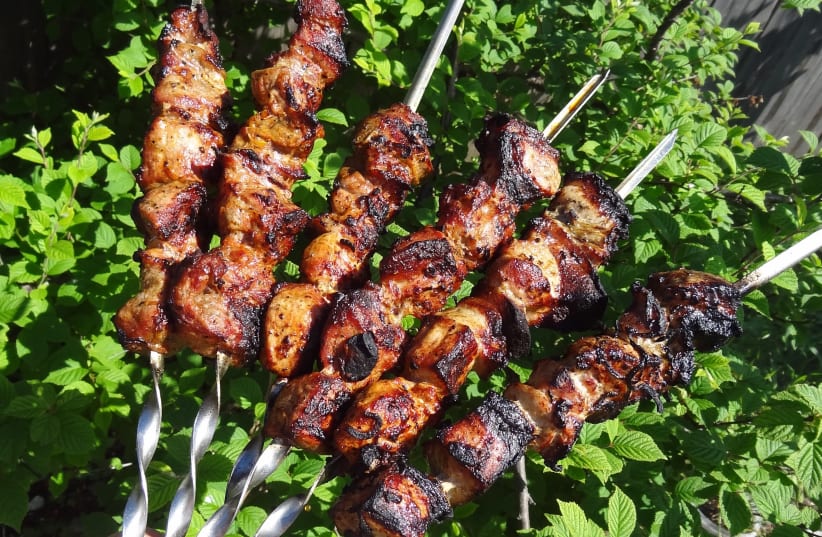What Jewish holiday is not mentioned in the Torah or anywhere until the 13th century and has no particular foods associated with it?
The answer is Lag Ba’Omer. The Torah does command us to begin on the second night of Passover and count the omer. Omer, which means “sheaf,” was a measure of grain from the new barley harvest cutting, brought to the Temple on the 16th of Nisan.
The barley was processed into flour; some of it was burned, and the rest was eaten by the priests. Fifty days later is Shavuot. Thus the counting of the omer provides a bridge between the Israelites being freed and receiving the laws. The seven-week period is a period of mourning when observant Jews do not shave or get haircuts and when there are no marriages or public festivities.
The respite is Lag Ba’Omer. The word “lag” is a combination of the Hebrew letters lamed, which stands for the number 30; and gimmel, which stands for the number three. The 33rd day of counting the omer commemorates the time when students of the second-century Rabbi Akiva (who supported Bar-Kochba’s rebellion against the Romans) were struck with a plague. On this day, it stopped.
One could then say, why didn’t those who created all the different symbolic foods for other holidays create something with barley or flour for this holiday?
In Jewish Holiday Cookbook by Joan Nathan, Lag Ba’Omer barely gets a mention as “a time for picnicking.” She suggests roast chicken, eggplant salad, German potato salad, Moroccan carrot salad, fresh fruit and cookies.
Of all my many Jewish and Israeli cookbooks, the only one in my collection that actually devotes an entire chapter to Lag Ba’Omer food is A Taste of Tradition by Ruth Sirkis. She says the bonfires mark the beginning of the outdoor cooking season and recommends: pickle dip, tehina dip, mini relish trays, mixed grill (shishlik and kebab), pita, baked potatoes, baked corn, fruit and lemonade.
Shish kebab, kebab, shashlik. For those who become confused by the words, the Food Lover’s Companion states that kebab, shish kebab and shashlik are used interchangeably and are the chunks of meat placed on a skewer. Sikh is the Arabic word for “skewer.”
HERE ARE some tips and recipes for grilling on a skewer.
- Flat or square skewers will keep food from revolving.
- If you spray the grill with vegetable spray before cooking, foods will not stick.
- Partially cook vegetables before threading them on a skewer so foods cook in the same amount of time.
Meat and Potatoes Shishlik
Since roasted potatoes are one of the primary foods for Lag Ba’Omer, here’s a recipe for potatoes and meat on a stick.
Makes 6 servings.
- 2 pounds beef, cubed
- 1/3 cup balsamic vinegar
- ¼ cup olive oil
- 1 Tbsp. Dijon mustard
- 1 Tbsp. Worcestershire sauce
- 2 Tbsp. soy sauce
- 1 Tbsp. cilantro or parsley
- 12 small red or white potatoes
- 2 small onions, quartered
- In a plastic bag, combine balsamic vinegar, oil, mustard, Worcestershire sauce, soy sauce and meat. Close and let marinate 2 hours or refrigerated 8 hours.
- Place potatoes in a saucepan and cover with water. Bring to a boil, reduce heat and cook for 15 minutes. Drain and place in a bowl.
- Pour some marinade into the bowl of potatoes and toss.
- Thread six skewers with meat cube, potato, meat cube, onion quarter, meat cube, potato, meat cube. Thread remaining potatoes and onions on extra skewers.
- Grill skewers 3 inches from the heat 5 minutes on each side (for medium rare), more for well cooked, basting with marinade before turning.
Lamb Kebab
Makes 6 servings.
- ½ cup olive oil
- 2 Tbsp. red wine vinegar
- 1 Tbsp. minced garlic
- 1½ tsp. Dijon mustard
- 3 pounds lamb, cubed
- 2 red bell peppers
- 2 green peppers
- 2 onions, quartered
- 12 mushrooms
- ½ cup cilantro, chopped
- Place olive oil, vinegar, garlic, mustard and lamb in a plastic bag, close, shake and set aside.
- Core and seed peppers, cut into 1x2 inch pieces. Add to marinade along with mushrooms. Place in refrigerator at least 4 hours.
- Place onion quarters on a plate and brush with some of the marinade. Thread meat on skewers, alternating with vegetables and allowing 3 pieces of lamb per skewer. Grill 3 inches from the heat for 5 minutes per side for medium-rare, brushing with marinade when turning.
Grilled Vegetables
Makes 8 servings.
- ¼ cup olive oil
- ¼ cup red wine vinegar
- 1 Tbsp. minced garlic
- 2 tsp. Dijon mustard
- ½ tsp. basil or oregano or Italian seasoning
- 2 red onions, quartered
- 1 red bell pepper cut in 1½ inch strips
- 1 green pepper cut in 1½ inch strips
- 4 halved plum tomatoes or 8 cherry tomatoes
- 4 squash cut in ½ inch pieces
- 1 eggplant cut in ½ inch pieces
- In a plastic bag, combine olive oil, wine vinegar, garlic, mustard and spices. Add vegetables, close bag, toss and let marinate at least 3 hours.
- Using one skewer for each vegetable, thread onto skewers allowing ½ inch between each. Grill 3 inches from heat source 3 to 5 minutes, carefully turning. Place marinade in a bowl. Slide vegetables off skewers into marinade and toss.
The writer is a Jerusalem-based journalist, author, compiler/editor of nine kosher cookbooks and food writer for North American Jewish publications. She created and has led walks of Mahaneh Yehuda in English since 2009.

